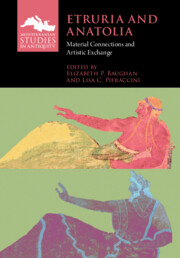Book contents
- Etruria and Anatolia
- Mediterranean Studies in Antiquity
- Etruria and Anatolia
- Copyright page
- Epigraph
- Contents
- Maps and Figures
- Contributors
- Preface
- Acknowledgments
- Notes on Abbreviations and Spelling
- Introduction
- Part I Broadening Perspectives
- Part II Interpretive Frameworks
- Part III Technology and Mobility
- Part IV Shared Practices
- 8 Etruscan Lightning and Anatolian Images
- 9 Luxury Consumption and Elite Lifestyles
- 10 Tracing Connections between Archaic Etruria and Anatolia in Material Culture and Funerary Ideology
- 11 Rock Tombs and Monuments in South Etruria and Anatolia
- Part V Shared and Distinct Iconographies
- Part VI Shared Forms, Distinct Functions
- Index
- References
9 - Luxury Consumption and Elite Lifestyles
from Part IV - Shared Practices
Published online by Cambridge University Press: 02 March 2023
- Etruria and Anatolia
- Mediterranean Studies in Antiquity
- Etruria and Anatolia
- Copyright page
- Epigraph
- Contents
- Maps and Figures
- Contributors
- Preface
- Acknowledgments
- Notes on Abbreviations and Spelling
- Introduction
- Part I Broadening Perspectives
- Part II Interpretive Frameworks
- Part III Technology and Mobility
- Part IV Shared Practices
- 8 Etruscan Lightning and Anatolian Images
- 9 Luxury Consumption and Elite Lifestyles
- 10 Tracing Connections between Archaic Etruria and Anatolia in Material Culture and Funerary Ideology
- 11 Rock Tombs and Monuments in South Etruria and Anatolia
- Part V Shared and Distinct Iconographies
- Part VI Shared Forms, Distinct Functions
- Index
- References
Summary
This paper compares how ideas of power, rank, and status were communicated in Etruria and Anatolia in the Orientalizing period by the use of material items and images. By employing and exhibiting specific objects, elites used a non-verbal language to communicate with each other across frontiers in the Mediterranean area as well as to show their wealth and their sophistication in their own surroundings. Trade networks have been discovered, analyzed, and exhibited on various occasions in the last decade. However, we now have to deal with the significance of the selection, collection, and use of certain luxury items to the ostentation of accumulated wealth that are better known from the courtly societies of the Near and Middle East. The desire for possessing these items can be perceived in personal or private as well as social terms. As many of the items belong to the sphere of banqueting, it is mandatory to link the two worlds in question vis-à-vis this praxis of consumption and social events.
- Type
- Chapter
- Information
- Etruria and AnatoliaMaterial Connections and Artistic Exchange, pp. 166 - 181Publisher: Cambridge University PressPrint publication year: 2023

